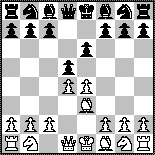Alapin-Diemer Gambit: 3. Be3!?
- "Alapin's idea. The sacrifice of the pawn seems to be correct,
for after 3... dxe4 4. Nd2 Black would get a very difficult game if he
tried to keep the pawn with 4... f5, while 4... Nf6 5. c3 and 6. Qc2
recovers pawn with good game."
- - R. Teichmann
There is one major problem in the classical
DDG: Black often plays the bishop to b4 to pin the
knight on c3, and usually White gets doubled c-pawns, which are hard
to protect. Therefore, I developed the following plan.
First of all, the e-pawn shall be sacrificed in any case. Because the
c4-move weakens the d4-pawn, White could play c3 instead. After that,
the knight has to be played to d2 -- and before that, the bishop to
e3.
The improved plan starts with 1. e4 e6 2. d4 d5 3. Be3.
Later I was told that the opening is known as the Alapin French
Variation. BDGers, who use to play f3, call this the
Alapin-Diemer Gambit (ADG).
The back cover of
Tim Sawyer's Alapin
French, Tactics for White (1995) says:
"Quick slashing attacks which often win in 20 moves."
ADG on the Web:
B

|
After the obvious 3... dxe4, the game may continue as follows.
|
4. Nd2 Nf6 (4... f5! 5. f3 Nc6 6. Bb5 Nf6 -/+
Keres)
5. c3 b6 6. g3 Bb7 7. Bg2 Be7
(7... c5!? with good chances for Black)
8. Qc2 O-O 9. Nxe4 =,
Mieses - Janowsky, Wien 1896.
5. f3
- 5... exf3 6. Ngxf3 b6 7. Bd3 Bb7 8. O-O Nbd7 9. c3 Be7 10. Qe2 O-O
11. Bc2 Rc8 12. Qd3 g6 13. Bh6 Re8 14. Ng5 c5 15. Rae1 cxd4 16. Rxe6?
dxc3? 17. Nxf7 Kxf7 18. Bb3 Kg8 19. Rxe7+ Kh8 20. Bg7# 1-0,
Heikkinen - Väätäinen, 1992.
- 5... Nd5 6. Qe2 c5 7. O-O-O (7. dxc5) Nxe3 8. Qxe3 Qxd4 9. Qxd4
cxd4 10. fxe4 e5 11. Ngf3 Nc6 -/+, 0-1 in 44,
Heikkinen - Pietarinen,
corr. 1995.
- 5... Nc6 6. c3 e5 =/+ Pachman.
If White plays c4 later on, the game may transpose to
rare DDG lines.
4. f3 c6
- 5. Nd2 exf3 6. Ngxf3 Nf6
- 5. fxe4 Qh4+ 6. g3 Qxe4 7. Qe2 Qxh1 8. Nf3 e5 9. Nbd2 Bh3
10. O-O-O Bxf1 11. Rxf1 Qxf1+ 12. Qxf1, Harmonist - Bardeleben.
The Caro-Kann Fantasy (Tartakower Variation) 1. e4 c6 2. d4 d5 3.
f3 would transpose to the ADG after 3... dxe4 4. Be3 e6.
MCO/13 (1990) says: "The fantasy variation is not theoretically
critical; it is not as outlandish as it looks and can be a surprise
weapon."
Unorthodox Openings
(1997) called this the
Maroczy Variation.
Pitt has
over 200 Caro-Kann Fantasy games.
4. Nc3
- 4... f5 5. f3 exf3 6. Nxf3 c6 7. Ne5 Nf6 8. g4 Nd5 9. Nxd5 Qxd5
10. Rg1 Bb4+ 11. c3 Be7 12. gxf5 Bh4+ 13. Kd2 O-O 14. Rxg7+ Kxg7 15.
Qg4+ Kh8 16. Qxh4 Rxf5 17. Ng6+ Kg7 18. Qh6+ 1-0,
Heikkinen - Väätäinen, 1992.
If I have ever played the BDG unintentionally, this must be the game.
- 4... Nf6 transposes to the Henneberger Variation.
1. d4 Nf6 2. Nc3 d5 3. e4 e6 4. Be3 is also known as the
Rasa-Studier Gambit.

